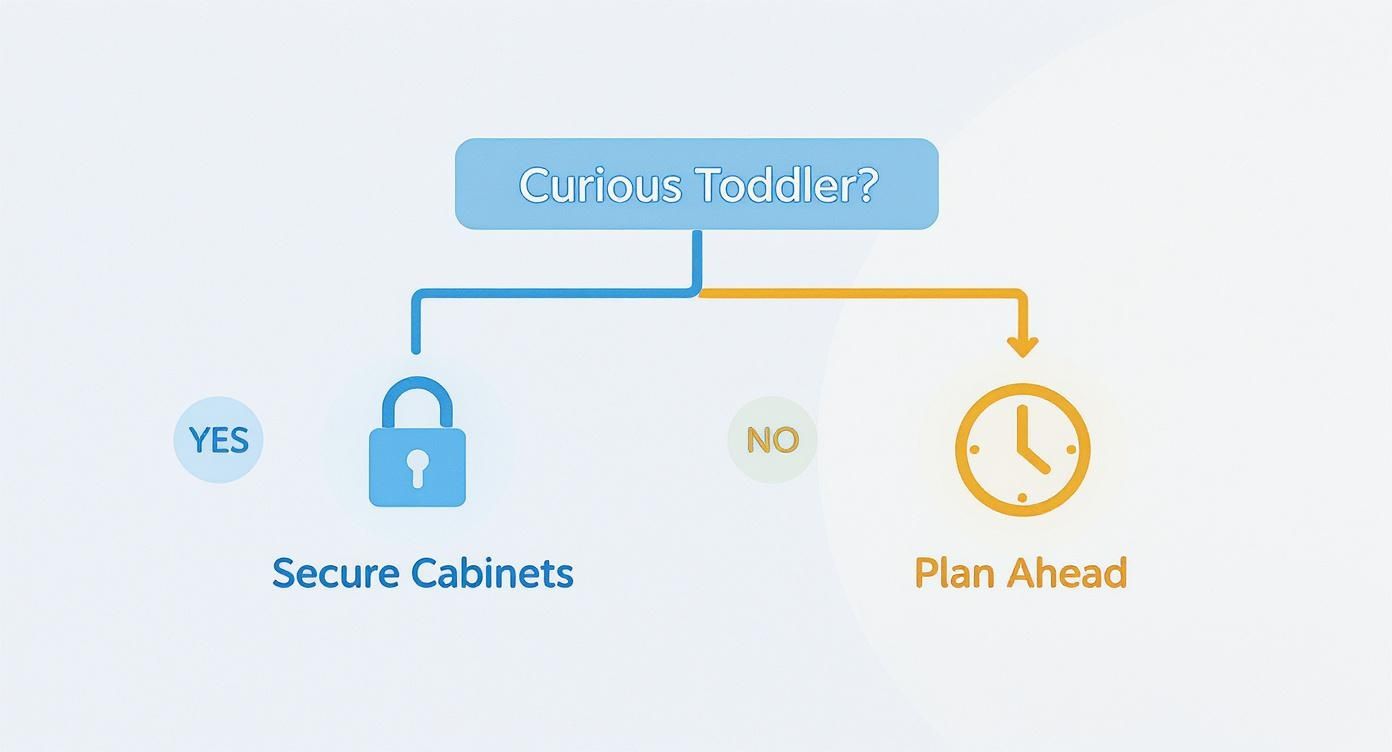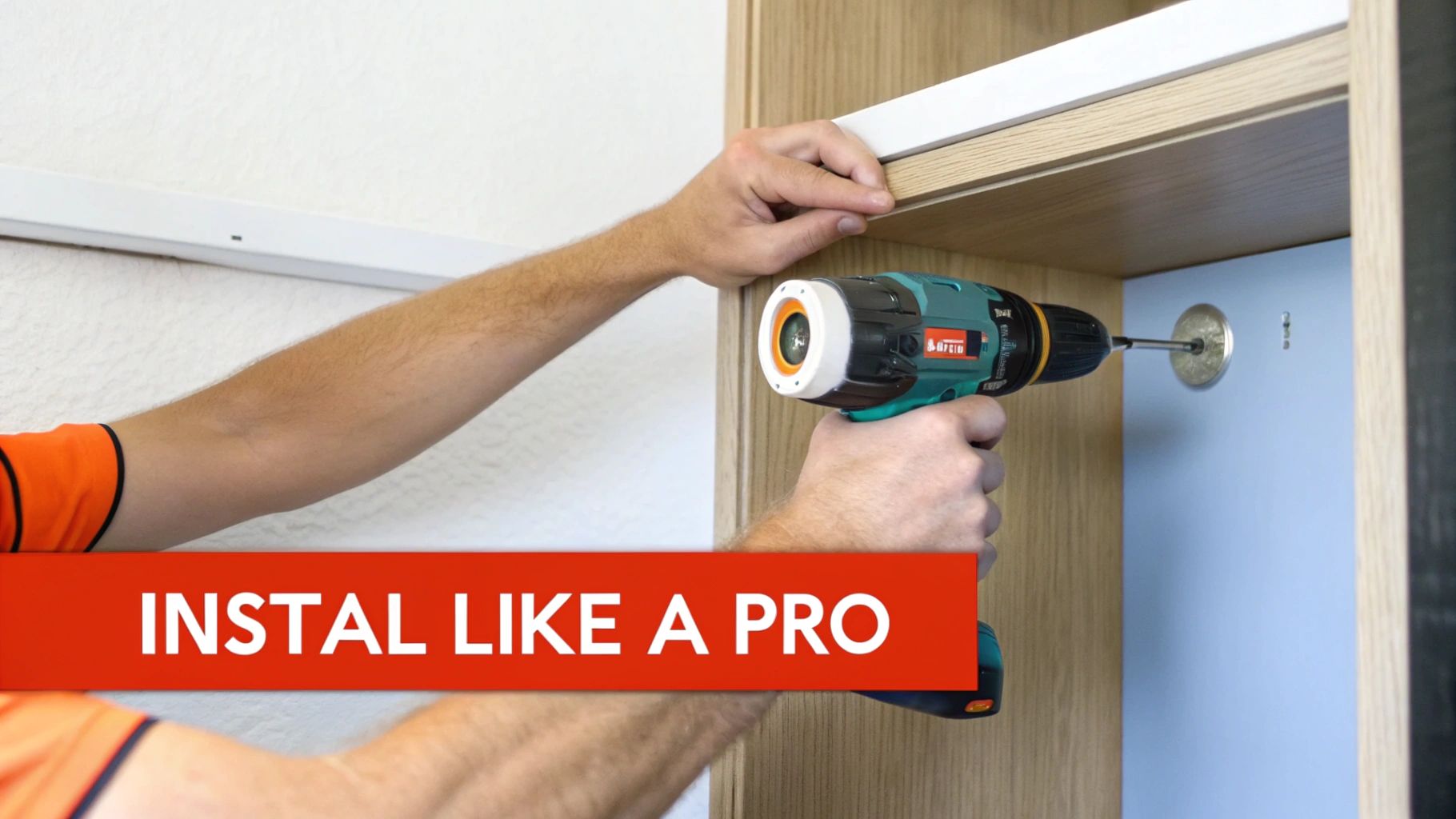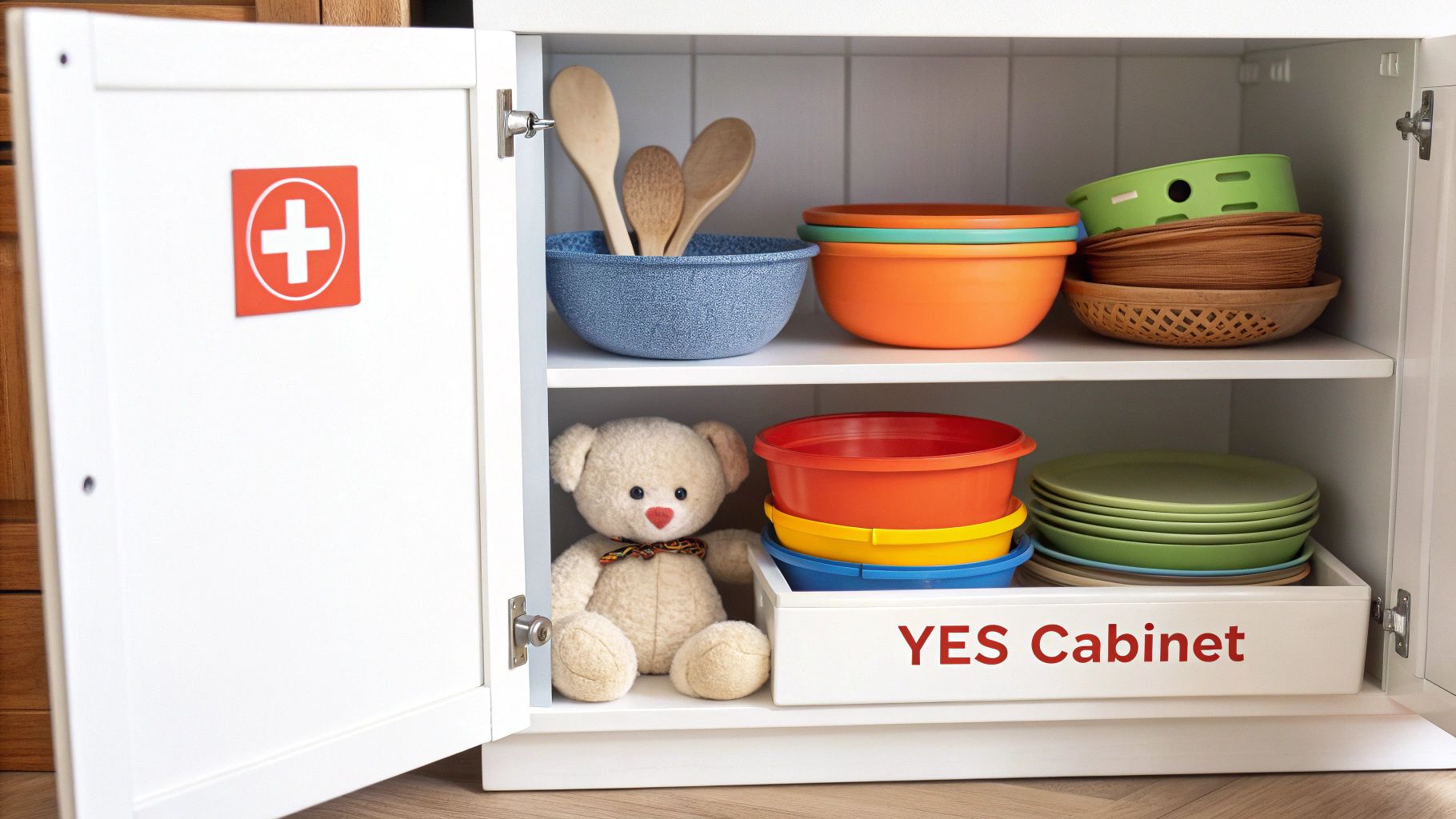
How to Baby Proof Cabinets: A Comprehensive Guide
Learning how to baby proof cabinets is a fundamental step in creating a safe home environment for a curious, mobile child. This process involves identifying potential hazards behind cabinet doors, selecting the most appropriate locking mechanisms for your home, and ensuring they are installed correctly for maximum effectiveness. Taking these steps is one of the most impactful actions you can take to protect your child from common household dangers.
Why Baby-Proofing Cabinets Is an Essential Safety Measure
For parents of a new crawler or toddler, the home environment begins to look very different. Every knob and handle becomes an object of intense curiosity, inviting exploration. While this curiosity is vital for development, it can also lead a child to significant dangers. Consider the contents of typical kitchen and bathroom cabinets: heavy cookware, sharp utensils, cleaning chemicals, and medications.
This is why securing your cabinets is not just a household chore—it's a critical safety protocol. The market for childproof cabinet locks was valued at USD 1.45 billion in 2024, which highlights the importance parents and caregivers place on this safety measure. Each year in the U.S., tens of thousands of accidental poisonings involving young children are reported, many of which occur because a child gained access to an unlocked cabinet.
The goal of baby proofing is not to restrict a child's exploration. It is to create a secure environment where they can explore safely, providing peace of mind for the entire family.
A Proactive Approach to Home Safety
Feeling overwhelmed by potential household risks is common, but addressing them proactively makes a significant difference. This guide provides a clear, effective plan for securing your cabinets thoroughly.
We will cover essential information, including:
- The primary types of cabinet locks and their ideal applications.
- Proper installation techniques to ensure genuine security.
- Additional strategies that complement the use of locks.
Securing cabinets is one part of a larger safety plan. For a complete room-by-room strategy, review our comprehensive guide on how to childproof your home.
Choosing the Right Cabinet Locks for Your Home
Selecting baby-proofing products can feel daunting due to the sheer number of options available. To effectively baby proof cabinets, you must find a lock that suits your family's lifestyle, your home's aesthetic, and your child's developmental stage. The objective is not merely to install a lock but to implement a solution that ensures safety without causing daily frustration.
Several main types of cabinet locks are available, each with distinct features. Understanding these differences is the first step toward making an informed and practical choice.
For an Invisible, High-Security Solution
If maintaining your home's aesthetic is a priority, magnetic locks are an excellent choice. These locks are mounted on the inside of the cabinet door and frame, making them completely invisible from the outside. A powerful magnetic "key" is used to disengage the lock from the exterior.
Magnetic locks are highly effective because a child cannot bypass them without the specific key. The main considerations are that installation can be more involved, sometimes requiring a drill for precise alignment, and the key must be kept in a safe but accessible location. It is highly recommended to store a spare key to avoid being locked out.
This visual guide outlines the key stages for implementing cabinet safety measures as your child grows.

As the infographic illustrates, once a child becomes mobile, securing low-level cabinets becomes an immediate priority, not a task to be postponed.
Simple, No-Drill Installation Options
For those who prefer to avoid tools or need a non-permanent solution, adhesive strap locks are highly practical. These flexible plastic straps feature a strong adhesive pad at each end; one attaches to the cabinet door and the other to the frame. The peel-and-stick installation is ideal for renters or anyone seeking a quick and easy setup.
The primary trade-off is their external visibility. A determined toddler may also weaken the adhesive over time with persistent effort, so periodic checks are important. Investing in a reputable brand often provides a more durable and reliable product, a key concept detailed in our article on why quality matters when investing in durable baby products.
Choosing a lock involves balancing security, aesthetics, and convenience. The most effective solution is one that aligns with your specific household needs and will be used consistently.
Cabinet Lock Comparison Guide
To simplify your decision-making process, this table compares the most common types of cabinet locks, helping you identify the best option for your home.
| Lock Type | Installation Method | Visibility | Best For |
|---|---|---|---|
| Magnetic Locks | Inside mount; often requires drilling | Invisible (hidden) | Homeowners who want top-tier security without compromising on aesthetics. |
| Adhesive Strap Locks | External adhesive; no drilling needed | Visible (external) | Renters, quick installations, and securing appliances like refrigerators. |
| Spring-Action Latches | Inside mount; requires drilling and screws | Mostly invisible | Budget-conscious parents who don't mind a small installation project. |
| Slide Locks | No installation; slides over knobs or handles | Visible (external) | Cabinets with double doors and side-by-side knobs or D-shaped handles. |
Ultimately, the best lock is one that is installed correctly and used consistently. The type of lock is secondary to its proper and regular implementation.
Other Effective Options
Two other common types of locks are worth considering:
- Spring-Action Latches: These classic, inexpensive internal latches require you to press down on a spring-loaded hook while opening the door. While effective, they often allow the door to open slightly, which can create a pinch hazard for small fingers.
- Slide Locks: Designed for cabinets with adjacent double-door knobs or handles, these U-shaped plastic locks slide over both, preventing them from being opened. They require no installation but are only suitable for this specific handle configuration.
Installing Cabinet Locks for Maximum Effectiveness

Once you have selected your locks, the next step is proper installation. A methodical approach at this stage will ensure a secure setup that can withstand a curious toddler's attempts to defeat it.
Before applying any adhesive, clean the cabinet surfaces thoroughly with rubbing alcohol and a clean cloth. This essential step removes grease, dust, or cleaning residues that can compromise the adhesive bond, ensuring the lock adheres securely.
Installing Adhesive Locks Correctly
When working with adhesive-mounted locks, patience is crucial for a successful installation. After cleaning the surface, position the lock without applying firm pressure. Check the alignment and confirm that the door or drawer can close properly.
Once you have confirmed the correct placement, press down firmly for 30 to 60 seconds to activate the adhesive bond.
The most common installation error is testing the lock immediately. Most adhesives require a curing period of 24 to 48 hours to reach their maximum strength. Resisting the urge to test the bond for a day or two will result in a much stronger and more reliable installation.
Consider placement carefully. A lock installed too low may still allow the cabinet door to open partially, creating a pinch point for fingers. It is recommended to place the lock as high as possible on the cabinet while ensuring it remains accessible for adults.
Mastering Magnetic and Drilled Lock Installation
While magnetic locks offer superior security, they require precise installation. A helpful technique for perfect alignment is to use painter's tape. First, assemble the two parts of the lock (the latch and the catch). Place a small piece of painter's tape over the catch mounted on the cabinet frame.
Next, gently close the door. The tape will transfer to the inside of the door, marking the exact position where the latch should be installed. This eliminates guesswork and prevents unnecessary drill holes.
When you are ready to drill, follow these best practices:
- Use the Correct Drill Bit: Always use the drill bit size specified in the manufacturer's instructions. A bit that is too large will result in loose screws and a less secure lock.
- Test Before Fully Tightening: Drill the pilot holes and insert the screws, but do not tighten them completely. Test the lock's function with the magnetic key several times. Once you confirm it operates smoothly, tighten all screws securely.
Taking a few extra minutes to ensure proper installation transforms a potential hazard into a truly safe space, providing valuable peace of mind.
Creative Safety Strategies Beyond Locks

Installing high-quality locks is the most critical first step, but a comprehensive approach to baby proofing involves creating layers of safety. While locks serve as the primary barrier, strategic organization provides essential backup protection, preventing a potential accident from becoming an emergency.
Begin by relocating all hazardous items—such as cleaning chemicals, dishwasher pods, and medications—to the highest possible cabinets. This should be done even for lower cabinets that are locked. This practice creates a vital failsafe in case a lock is accidentally left unlatched.
The Benefit of a "Yes" Cabinet
To manage a toddler's natural desire to explore the kitchen, consider creating a “yes” cabinet.” This strategy is highly effective for redirecting curiosity in a safe and positive way.
The concept is to designate one lower cabinet to remain unlocked and fill it with items that are safe for a child to play with.
- Plastic food storage containers and lids
- Wooden spoons and silicone spatulas
- Small, lightweight pots and pans
This provides a designated space for exploration and play, satisfying their desire to participate in household activities in a safe and engaging manner.
By providing a toddler with their own safe space to discover, you can reduce frustration and power struggles. This approach acknowledges their curiosity and channels it constructively, rather than simply restricting it.
This proactive mindset is reflective of a broader trend in parenting. The global baby proofing market reached a value of approximately USD 229.18 billion in 2023 and is projected to continue growing as parental awareness of home safety solutions increases. You can review the data in this market research on baby proofing products.
When you combine physical barriers like locks with smart organizational strategies, you create a home that is truly safe for a developing child. It is about building a system where curiosity is encouraged within secure boundaries.
Maintaining Your Cabinet Locks for Long-Term Security
Once your cabinet locks are installed, the task is not complete. The initial setup is just the beginning; ongoing maintenance is essential to ensure your child remains safe as they grow.
First, it is important to test your work from a child's perspective. Get down on the floor and attempt to defeat the locks. Pull firmly on each door and drawer. Wiggle it to check for any gaps. A space that seems insignificant to an adult may be large enough to pinch a child's fingers. If you can create a gap, you may need to adjust the lock or choose a different type for that specific cabinet.
Make Regular Lock Checks a Habit
Children grow stronger and more resourceful quickly. A lock that was secure one week might be challenged by a more determined toddler the next. This is why regular inspections are so important.
Set a recurring reminder to conduct a brief safety audit every few weeks. This quick check can make all the difference.
- For adhesive locks: Gently but firmly pull on the lock to ensure the bond remains strong. Environmental factors like steam, humidity, and temperature fluctuations can weaken adhesive over time.
- For screw-in locks: Verify that all screws are tight. The repetitive motion of opening and closing a cabinet can sometimes cause them to loosen.
- Involve older children: If you have older children in the home, ensure they understand the purpose of the locks and teach them to re-latch them every time. An unlatched lock is the most common point of failure in an otherwise secure system.
A proactive maintenance approach transforms a one-time project into a reliable, long-term safety system. These consistent checks are what make your baby-proofing efforts truly effective as your child develops.
This diligence is a key reason why child safety locks are a major consumer category, with over 300 million units sold globally each year. It addresses a universal concern for parents, which is reflected in data on parental safety concerns and market trends on MarketReportAnalytics.com.
If you discover a lock that is loose, damaged, or malfunctioning, replace it immediately.
Common Questions About Baby Proofing Cabinets
As you begin the process of baby proofing, several practical questions often arise. Addressing these common concerns can help you feel more confident in your safety plan.
When Should I Start Baby Proofing?
The ideal time to baby proof is before you believe it's necessary. It is recommended to have cabinet locks installed by the time your child is six months old.
Pay close attention to early signs of mobility, such as when your baby begins to roll, attempt to crawl, or pull up on furniture. The transition from stationary to mobile can happen very quickly.
Will Cabinet Locks Damage My Cupboards?
The potential for damage depends entirely on the type of lock you choose.
Adhesive locks are designed for clean removal and are an excellent option for preventing damage. When it is time to remove them, gently warm the adhesive with a hairdryer before peeling it away slowly. This method typically prevents any residue or surface damage.
Conversely, locks that are installed with screws will leave small holes.
The minor cosmetic repair required after removing drilled-in locks is often considered a small trade-off for the superior security they provide, especially for cabinets containing hazardous materials.
What Is the Best Option for Renters?
For those living in rental properties, adhesive strap locks and slide locks are ideal choices. They provide effective security without drilling, ensuring you do not violate the terms of your lease agreement.
To maximize the effectiveness of adhesive locks, always clean the cabinet surface with rubbing alcohol before application to create a strong, durable bond.
If you have additional questions, our detailed frequently asked questions page offers further insights to help you make the best decisions for your family's safety.
At MiniPrecious, we understand that your baby's safety is your top priority. Explore our collection of high-quality, parent-approved baby essentials designed to give you peace of mind. Visit us at https://miniprecious.com to find everything you need for your little one.

